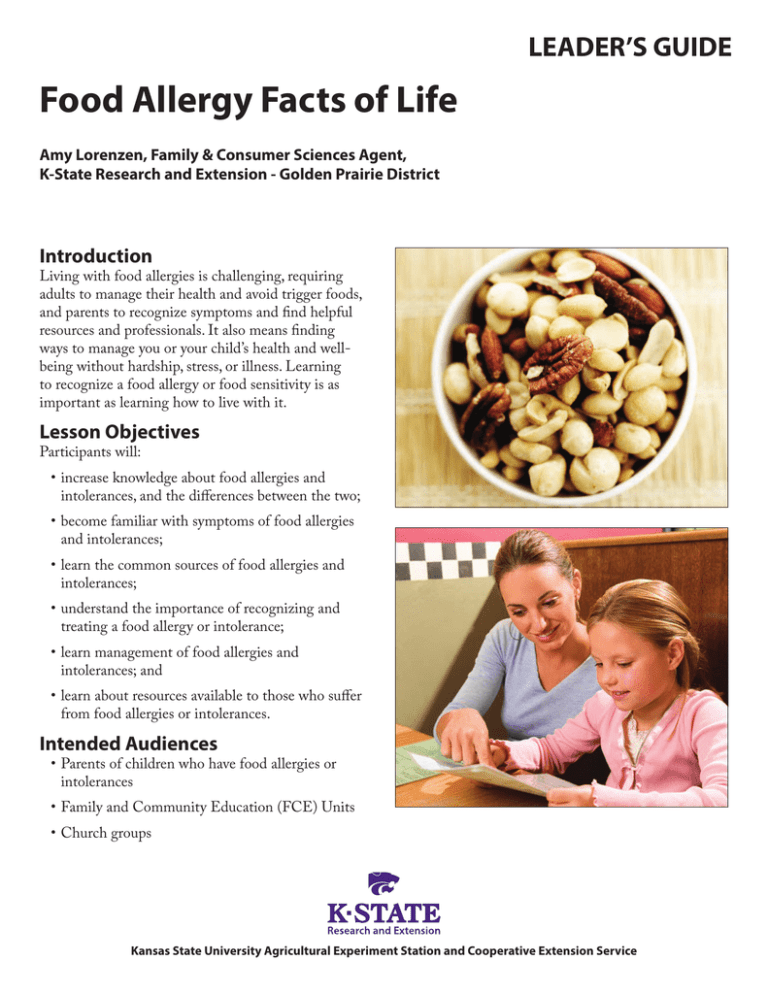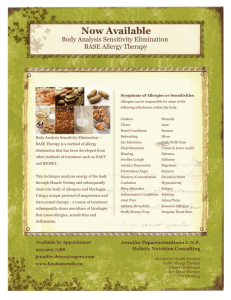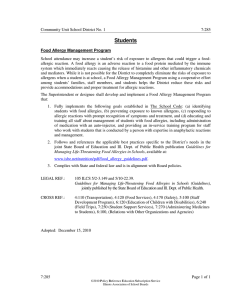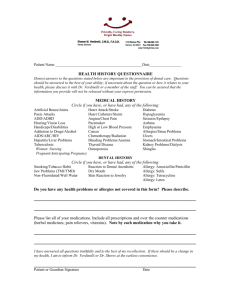
LEADER’S GUIDE
Food Allergy Facts of Life
Amy Lorenzen, Family & Consumer Sciences Agent,
K-State Research and Extension - Golden Prairie District
Introduction
Living with food allergies is challenging, requiring
adults to manage their health and avoid trigger foods,
and parents to recognize symptoms and find helpful
resources and professionals. It also means finding
ways to manage you or your child’s health and wellbeing without hardship, stress, or illness. Learning
to recognize a food allergy or food sensitivity is as
important as learning how to live with it.
Lesson Objectives
Participants will:
•increase knowledge about food allergies and
intolerances, and the differences between the two;
•become familiar with symptoms of food allergies
and intolerances;
•learn the common sources of food allergies and
intolerances;
•understand the importance of recognizing and
treating a food allergy or intolerance;
•learn management of food allergies and
intolerances; and
•learn about resources available to those who suffer
from food allergies or intolerances.
Intended Audiences
•Parents of children who have food allergies or
intolerances
•Family and Community Education (FCE) Units
•Church groups
Kansas State University Agricultural Experiment Station and Cooperative Extension Service
•Work groups and other community groups
•Day care and school personnel
•Senior citizen groups
Before the Lesson
•Review the leader’s guide and fact sheet (MF3083)
and the PowerPoint slideshow, if you plan to use
it. (Download from the K-State Research and
Extension Family and Consumer Science website,
at www.ksre.ksu.edu/FCS/p.aspx?tabid=87).
•Obtain copies of fact sheet — Food Allergy Facts of
Life, MF3083 — for each participant.
•Make copies of the participant survey to use at the
end of the lesson.
•Review three or more of the websites listed under
Reputable Resources.
•Gather materials or examples (downloaded from
the website or listed in the supplemental materials)
for each participant.
•Talk with someone who has a food allergy or
intolerance to learn what living with the condition
is like. Consider asking that person to come to your
presentation and share his or her experiences.
•Review important terms.
Important Terms
Allergen (al-ler-gen) — a substance that’s capable of
producing an allergic reaction.
Anaphylaxis (an-a-fil-lax-is) — a serious, sometimes
life-threatening, allergic reaction.
Epinephrine (ep-i-nef-fren) — a substance used to
stop an anaphylactic reaction.
Food allergy — an immune system reaction that
occurs soon after eating a certain food.
Food Allergy Action Plan — emergency care plan to
be carried at all times.
Food intolerance — delayed response to a food that
does not involve the immune system.
Histamine (hiss-ta-mean) — chemical released
by antibodies that produces the itching or swelling
associated with allergic reactions.
Immunoglobulin (im-mu-no-glob-u-lin) —
antibodies that help fight infection in the body.
IgE (eye-gee-ee) — immune system antibodies found
in the respiratory tract, intestines, skin, and other body
organs.
Medical history — a review of past illnesses and
issues.
RAST, radioallergosorbent test (ray-de-o aller-go
sorb-ent test) — blood test used to diagnose presence
of IgE antibodies.
Skin prick test — an allergy test that involves putting
a small amount of allergen on a probe with a sharp tip
and pricking the skin with it.
Three R’s — Recognize the symptoms, React quickly,
and Review what caused the reaction and how well the
action plan worked.
Introduction Suggestions
If you or someone you know has a food allergy or food
intolerance, invite them to the presentation to share
their experience. This can help the audience identify
with the issues involved with food allergies and help
them understand how allergies affect lives. Allow time
for discussion about the audience’s own experiences
with food allergies or intolerances.
Supplemental Materials
Each participant should receive a copy of the
supplemental materials. Take time to review some of
the more common names for food allergens.
PowerPoint
Use of the PowerPoint presentation is highly
recommended. Ask your county or district K-State
Research and Extension office for use of a projector
and computer if you do not have one available to you.
Reputable Resources
The Food Allergy and Anaphylaxis Network. www.
foodallergy.org. A great resource for learning all you can
about food allergies.
Kids with Food Allergies. kidswithfoodallergies.org. Site
dedicated to children’s food allergies. Has printable
resources, recipes, online chat rooms, and activities.
The American College of Asthma, Allergy and
Immunology. www.acaai.org. Site with information about
food allergies, references to help you find an allergist, and
more.
National Institute of Allergy and Infectious Diseases.
www.niaid.nih.gov/topics/foodallergy/Pages/default.aspx.
Website with information about food allergies, including
frequently asked questions and more.
Food Allergies and Food Intolerance — The Complete Guide
to Their Identification and Treatment. Jonathon Brostoff,
M.D., Linda Gamlin, Healing Arts Press, 2000. ISBN:
13:978-089281875-4.
Food Allergies for Dummies. Robert A. Wood, M.D. Wiley
Publishing, 2007. ISBN: 978-0-470-09584-3.
Understanding and Managing Your Child’s Food Allergies.
Scott H. Sicherer, M.D., The Johns Hopkins University
Press, 2006. ISBN: 13:978-0-8018-8492-4.
Author
Amy Lorenzen, Family & Consumer Sciences Agent,
K-State Research and Extension - Golden Prairie District,
amyloren@ksu.edu
Reviewers
Mary Meck Higgins, Associate Professor of Human
Nutrition and K-State Research and Extension Human
Nutrition Specialist, Kansas State University.
Tranda Watts, Multi-County Specialist, Nutrition, Food
Safety and Health, K-State Research and Extension,
Golden Prairie District and Twin Creeks District.
Participant Survey: Food Allergy Facts of Life
1. As a result of this information, I learned that food allergies can be managed. T
F
2. As a result of this information I learned the about the main foods that cause food allergies. T
3. I learned that a food intolerance can be to any food. T
F
F
4. As a result of this information, I learned ways to manage a food allergy or intolerance. T
F
5. I learned that reading ingredient labels on foods, cosmetics, bath products, laundry detergents and other items is vital if I or a
loved one has a food allergy or intolerance. T
F
6. As a result of this information, I have found new resources to help me or my family member in dealing with food allergies/food
intolerances. T F
Publications from Kansas State University are available at: www.ksre.ksu.edu
Publications are reviewed or revised annually by appropriate faculty to reflect
current research and practice. Date shown is that of publication or last revision.
Contents of this publication may be freely reproduced for educational purposes.
All other rights reserved. In each case, credit Amy Lorenzen, Food Allergy Facts of
Life, Leader’s Guide, Kansas State University, July 2013.
Kansas State University Agricultural Experiment Station and Cooperative
Extension Service
K-State Research and Extension is an equal opportunity provider and employer.
Issued in furtherance of Cooperative Extension Work, Acts of May 8 and June
30, 1914, as amended. Kansas State University, County Extension Councils,
Extension Districts, and United States Department of Agriculture Cooperating,
John D. Floros, Director.
MF3084
August 2013




